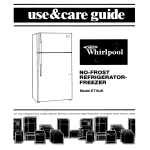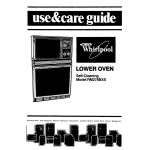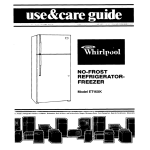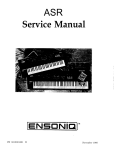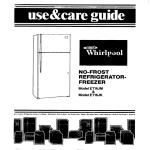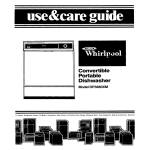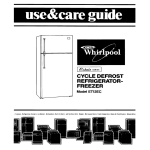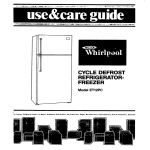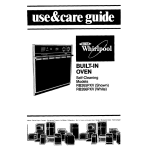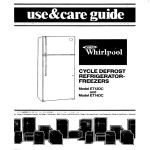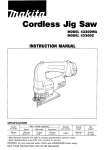Download NO-FROST REFRIGERATOR- FREEZER
Transcript
NO-FROST REFRIGERATORFREEZER Model ETWM ws, Freezers. Refrigerator-Freezers. Ice Makers, Olshwashers. Bwlt-In Ovens and Surface Unrts, Ranges, MIcrowave Ovens, Trash Compactors. Room Aw Conditioners, Oehumldll Please read this Use and Care Guide before you do anything else.. . This booklet tells you how to start your refrigerator, clean it, move shelves and adjust controls. It even tells you what new sounds to expect from your refrigerator. Treat your new refrigerator with care. Use it only to do what home refrigerators are designed to do. Parts and features Automatic Ice Maker Refrigerator Control / - Power Saver Control Freezer Control Levelling % Roller Leg Number Copy your Model and Serial Numbers When you need service oi call with a question, have this information ready: 1. Complete Model and Serial Numbers plate located as shown). here... Model Number [from the Serial Number 2. Purchase date from sales slip [or date installed) Copy this information in these spaces. Keep this book, your warranty and sales slip together in a handy place. 2 Purchase Date Service Company and Telephone Number Plate Contents SAFETY FIRST BEFOREYOUPLUGITIN .,.............. Install Properly Level Refrigerator-Freezer Remove Sales Labels Clean It Plugltln .,,,..,,,.,......,.,., ..., USING YOUR REFRIGERATOR. Setting the Controls Power Saving Control Changing the Control Settings Adjusting the Shelves Removing Crisper and Crisper Cover Changing the Light Bulb Page 3 3 4 4 4 4 4 5 5 5 5 6 6 6 Automatic Ice Maker Sounds You May Hear. Energy Saving Tips CLEANING YOUR REFRIGERATOR Cleaning Chart FOOD STORAGE GUIDE. Storing Fresh Food Storing Frozen Food VACATION AND MOVING CARE IF YOU NEED SERVICE OR ASSISTANCE. 1 Before Calling for Assistance 2. If You Need Assistance 3.IfYouNeedService ,,...,,,,,.,,., 4.IfYouHaveaProblem ,,,.,,,,,,,., :~,I985 Whirlpool Page 6 7 7 7 8 9 9 10 10 11 11 11 11 11 Corporation Before you plug it in *<>, _ I,-,..) IMPORTANT Before using your refrigerator, you are personally responsible for making sure that it... l is installed and leveled on a floor that will hold the weight, and in an area suitable for its size and use. l is connected only to the right kind of outlet, with the right electric supply and grounding. l is used only for jobs expected of home refrigerators. l is not near an oven, radiator OTother heat source. l l l l l l is properly maintarned. is out of the weather. is used in an area where the room temperature will not fall below 55” F (13” C). is not run where there are explosive fumes. is not used by children or others who may not understand how it should be used. is not loaded with food before it has time to get properly cold. -,*. , I. I ‘3 Install properly.. . Remove sales labels.. . 0 II r- I/ Clean it.. . -’ 1. Allow 3 inches (7.5 cm) between overhead cabinets and the refrigerator top. 2. Allow at least an inch (2.5cm) between the refrigerator condenser and the wall. 3. Allow J/ZInch (1.25 cm) on each side of the refrigerator for ease of installation. 4. If the refrigerator is to be against a wall, you might want to leave enough space so the door can be opened wider. Level refrigerator-freezer.. Remove the Consumer Buy Guide label, tape and any inside labels before using the refrigerator To remove any remaining glue: I. Rub briskly with thumb to make a ball then remove OR 2 Soak area with dishwashing detergent solution (1 teaspoon detergent in 1 quart warm water) before removing glue as described in step 1. DO NOT USE rubbing alcohol or flammable or toxic solvents, such as acetone, gasoline, carbon tetrachloride, etc. These can damage the material. NOTE: DO NOT REMOVE ANY PERMANENT INSTRUCTION LABELS INSIDE YOUR REFRIGERATOR. Do not remove the Tech Sheet fastened under the refrigerator at the front. Af Clean your refrigerator ing instructions on pages before using it. See clean7 and 8. Plug it in... . Refrigerator Power Cord RECOMMENDED 1. Keep the 4 bolts that hold refrigerator In shipping crate. They are the levelling legs. 2. Screw these bolts all the way into bolt holes at the bottom corners of refrigerator. Roll refrigerator into place. 3. Lower legs just enough to lift rollers off floor. 4. Adjust each until the refrigerator won’t rock. 5. Adjust front legs to level the refrigerator. -To raise corners, turn legs counterclockwise. -To lower corners, turn legs clockwise. 6. Check with level. 4 GROUNDING METHOD A 115 Volt, 60 Hz., AC only 15 or 20 ampere fused and properly grounded electrical supply IS required. It IS recommended that a separate circuit serving only this appliance be provided. Do not use an extension cord. Use a receptacle which cannot be turned off with a switch or pull chain. See individual electrrcal requrrements and grounding instruction sheet in your Irterature package. Using your refrigerator Refrigerator Setting Control / Power Saving the controls.. . I. Set the REFRIGERATOR CONTROL to 3. Glve the refrigerator pletely before adding eral hours.) be about usage. right for normal The controls will be set about right when milk or juice is as cold as you like and when Ice cream is firm. Power Saving Control.. .CONI”MtS . The Power Saving Control on the Control Console operates electric heaters around the door openings. These heaters help keep moisture from forming on the outside of the refrigerator. the control settings.. If Refrigerator Section IS TOO WARM If Freezer Section IS TOO WARM If Refrigerator Section is TOO COLD If ICE isn’t MADE FAST ENOUGH If BOTH SECTlbNS are TOO WARM POWER ~, ,t55 , EHtl‘” . SAYER RtWCLS tlTEII0 #I UOISI”SE. 1, Use the ‘CONSUMES LESS ENERGY” setting when humidity is low. 2 Use the “REDUCES EXTERIOR MOISTURE” setting only if moisture forms on the outside of the refrigerator. l l l : ~ . If you need to adjust temperatures in refrigerator or freezer, use the settings listed in the chart below. QUESTIONS? ,-catt your COOL-LINE” service assistance telephone number (page 11). time to cool down comfood. (This may take sev- These settings should household refrigerator 2. Set the FREEZER CONTROL to B. CONDITION Control Control Controls for the refrigerator and freezer are in the refrigerator. When the refrigerator IS plugged In for the first time... Changing Freezer Light Switch Adjust the Refrigerator Control first. Wait at least 24 hours between adjustments Then adjust the Freezer Control, if needed. REASONS: Door opened often Large amount of food added Room temperature too warm Door opened often Large amount of food added Very cold rcom temperature [can’t cycle often enough) Controls not set correctly for your conditions Heavy ice usage Very cold room temperature (can’t cycle often enough) Door opened often Large amount of food added Very warm or very cold room temperatures RECOMMENDED SETTINGS: CONTROL Refrigerator Freezer 4 C Refrigerator Freezer 3 A Refrigerator Freezer 2 B Refrigerator Freezer 3 A Refrigerator Freezer 4 B Adjusting Automatic the shelves.. . ‘--& GuideStoPh Jtsz27h ice maker.. . Shelf Stop I. First, remove food from shelf. 2. Slide shelf straight out to stop. 3. Lift front. 4. Slide the rest of the way out. ReDlaCina Shelt: 1. iit bacrof shelf on top of gurdes with wire stops on the bottom of guides. 2. Lift front, slide shelf In until it clears guide stops. Removing cover.. . crisper and crisper L~fl the Front. Then the Back Pull out to stop Lift the Front and Pull Agaln Removing Crispers: 1 Slide crisper straight out to stop. 2. Lift the front 3. Slide the rest of the way out. 4. Replace In reverse order. Removing Cover: l Lift front, then lift back. l Pull up and out. Replacing Cover: I, Frt notches on back of cover into back wall of refrigerator. 2. Lower front into place. Changing WARNING: nubs on the light bulb.. . Before removing the light bulb, either unplug the refrigerator or disconnect the electricity leading to the refrigerator at the main power supply. Shock and injury can occur if electricity remains connected. I, Reach behind control console to find bulb. 2 Remove bulb. 3. Replace with a 40.watt appliance bulb 6 Raise Signal Arm to Stop Ice Maker. Lower Signal Arm to Start It. If you have the automatic ice maker accessory or plan to add one later (Part No. ECKMF-83). there are a few things you will want to know: l The ON /OFF lever is a wire signal arm. Down.. .for making ice automatically; Up...toshut off the ice maker. l Shake the bin occasionally to keep cubes separated, and to obtain increased storage capacity. l It is normal for ice crescents to be attached by a corner. They will break apart easily. l You will hear water running when ice maker IS working. You’ll hear ice fall into the bin. Don’t let these sounds bother you. l The ice maker will not operate untrl the freezer is cold enough to make ice. This can take overnight. l Because of new plumbing connections. the first ice may be discolored or off-flavored. Discard the first few batches of ice. l If ice is not being made fast enough and more ice is needed, turn the Refrigerator Control toward a higher number. Wait a day and, if necessary, turn the Freezer Control toward A. l If you remove the ice bin, raise the signal arm to shut off the ice maker. When you return the bin, push it all the way in and lower the arm to the ON positron. l If cubes are stored too long, they may develop an off-flavor...lrke stale water. Throw them away. They will be replaced. Cubes in the ice bin can also become smaller by evaporation. l The ice maker water supply should not be Softened water. The chemicals could damage the ice maker molds. +%-P/3,,\ -.-i Sounds you may hear... Your new refrigerator may make sounds that your old one didn’t. Because the sounds are new to you, you might be concerned about them. Don’t be. Most of the new sounds are normal. Hard surfaces like the floor, walls and cabinets can make the sounds seem louder. The following chart describes the kinds of sounds that might be new to you, and what may be making them. Possible Sounds: l Slight Hum, Soft Hiss: Clicking Sounds: l l l l or Snapping Probable Causes: may hear the refrrgerator’s YOU fan motor and moving arr. The defrost timer makes a definite click when the refrigerator also makes a sound when the refrigerator starts. stops running. It Water Sounds: When the refrigerator stops running, you may hear gurgling in the tubing for a few minutes after it stops. You may also hear defrost water running into the defrost water pan. Ice Maker Sounds: - trickling water -thud (clatter of ice) When the ice maker ISrunnrng, you may hear a buzzing [from the water valve). trrckling water and the clatter of Ice dumped Into the bin Running Your refrigerator has a high-efficiency compressor and motor. It will run longer than older designs. It may even seem to run most of the time. Sounds: Energy saving tips.. . You can help your refrigerator use less electricity. Check door gaskets for a tight seal. Level the cabinet to be sure of a good seal. l Clean the condenser coils regularly. l Open the door as few times as possible. Think about what you need before you open the door. Get everything out at one time. Keep foods organized so you won’t have to search for what you want. Close door as soon as food is removed. l Go ahead and fill up the refrigerator, but don’t overcrowd it so air movement is blocked. l l Cleaning your refrigerator.. l l It is a waste of electricity to set the refrigerator and freezer to temperatures colder than they need to be. If ice cream is firm in the freezer and drinks are as cold as your family likes them, that’s cold enough. Keep the Power Saving Control on CONSUMES LESS ENERGY unless moisture forms on refrigerator exterior. Make sure your refrigerator is not next to a heat source such as a range, water heater, furnace. radiator, or in direct sunlight. . Both the refrigerator and freezer sections defrost automatically. But both should be cleaned about once a month to help prevent odors from burlding up. Of course, spills should be wrped up right away TO clean your refrigerator, turn the Refrigerator Control to OFF. unplug It. take out all removable parts. and clean It according to the followrng directions. 7 Cleaning chart.. . How to clean Part What to use Removable parts (shelves, crrsper, etc.] Sponge or cloth; mild detergent and warm water Sponge, cloth or paper towel; mild detergent. applrance wax [or good auto paste wax] Outside l l l l l Waxing Inside walls [Freezer should be allowed to warm up so cloth won’t stick ] painted metal Sponge, soft cloth or paper towel, baking soda, warm water, mild detergent Sponge, soft cloth or paper towel, mild detergent, warm water DO NOT USE Cleaning bleaches or cleansers Mild detergent and warm water, soft, clean sponge and soft, clean cloth Dark panels Defrost pan (behind refrigerator and on top of the motor]. Condenser coils l l l rust protection. Wash with warm water and - mild detergent or ~ baking soda (2 tablespoons 1 quart I 95 I I warm water Rinse and dry Wash with mild detergent water Rinse and dry [ 26 gl to and warm parts. Wash with a soft grit-free cloth or sponge 9 Rinse and dry with a damp grit-free cloth or chamois l DO NOT USE paper towels, window sprays, scouring cleansers, or solvents like acetone, benzine, carbon tetrachloride, etc. These can scratch or damage the material. Sponge or cloth; mild l Roll refrigerator out only as far as water detergent and warm supply line allows l Wipe or wash defrost pan with warm water. water and mild detergent. Do not remove defrost pan to clean. l Rinse and dry. l Roll refrigerator back. Vacuum cleaner; using the brush attachment. l Usual floor cleaners l l l l 8 provides waxes, concentrated detergents, containing petroleum on plastic l Floor under refrigerator Wash with warm water and a mild detergent. Do not use abrasive or harsh cleansers. Rinse and dry Wax painted metal surfaces at least twice a year wrth appliance wax or a good auto paste wax. Apply wax with a clean, soft cloth. Do not use wax on plastic parts. surtaces l Door liners and gaskets Wash removable parts with warm water and a mild detergent. Rinse and dry Clean dust and lint from condenser coils behind the refrigerator at least every other month. Leave one inch (2.5 cm] between wall and condenser coils. Roll refrigerator out only as far as water supply line allows Wash floor. Roll refrigerator back. Check to see if the refrigerator is level. Food storage guide STORING FRESH FOOD There is a right way to package and store refrigerated 01 frozen foods. To keep foods fresher, longer, take the time to study these recommended steps. Leafy Vegetables.. Remove store wrapping and trim or tear off bruised and discolored areas. Wash In cold water and drain. Place In plastic bag or plastic container and store in crisper. Cold, moist air helps keep leafy vegetables fresh and crisp. Vegetables with Skins (carrots, peppers)...Store in crisper, plastic bags or plastic container. Fruits ...Wash. let dry and store in refrigerator in plastic bags or crisper. Do not wash or hull berries until they are ready to use. Sort and keep berries in their store container in a cnsper, o( store in a loosely closed paper bag on a refrigerator shelf. Meat= Meat IS perishable and expensive you won‘t want to waste an ounce of it through careless handling. The following list and chart give you packaging hints and time limits. Fresh, Prepackaged Meat. Store fresh meat in the store wrapping. Vacuum packaged meat can be frozen for as long as one month if the seal is not broken. If you want to keep it frozen longer, you should wrap it with special freezer wrapping material. Fresh Meat, Not Prepackaged. Remove the market wrapping paper and re-wrap in aluminum foil for storing it unfrozen. Cooked Meat. Wrap or cover cooked meat with plastic wrap or aluminum foil. Store immediately. Cured or Smoked Meat and Cold Cuts. Ham, bacon, sausage, cold cuts, etc., keep best in original wrappings. Once opened, tightly re-wrap in plastic wrap or aluminum foil. Canned Ham. Store in refrigerator unless the label says it’s okay to store on the shelf. Do not freeze. Fresh Poultry...Wrap in plastic wrap. The plastic wrap on poultry, as purchased, may be used for storage STORAGECHARTFOR FRESHAND CUREDMEAT* &pro&de TyLpe wvj ,y; .................... VarIqty Meats Chlcken . . . . . . . . . . . . . . . . . . . . . . . . . . 1 to2 GroundBeet . . . . . . . . . . . . . . . . . . . . . . 1 to2 SteaksandRoarh . . . . . . . . . . . . . . *. 3 to5 CwedMeats . . . . . . . . . . . . . . ..-.. i. 7 to10 ~Bacon . . . . . . . . . . . . . . . . . . . . . . . . . . . . 6to7 ColdCuts . . . . . . . . . . . . . . . . . . . . . . . . 3 to5 *If meat Is to be stored longer than the ties given, follow~hedlrectiwdfor~. NOTE: Fresh fish and shellfish should be used the same day as purchased. Eggs Store without washing in the original carton or use the egg nest in the doot of your refrigerator. Milk...Wipe milk cartons. For best storage, place milk on interior shelf. Beverages...Wipe bottles and cans. Store on a door shelf or inslde the refrigerator. Butter ..Keep opened butter in a covered dish or on the Butter Dish in the Butter Compartment. When storing an extra supply, wrap in freezer packaging and freeze. Cheese .Store in the original wrapping until you are ready to use it. Once opened, re-wrap tightly in plastic wrap or aluminum foil. Condlments .Store small jars and bottles (catsup. mustard, jellv. olives) on the door shelves where they are in easy reach. Leftovers...Cover leftovers with plastic wrap or aluminum foil to keep food from drying out and transferring food odors. Plastic containers with tight lids are fine. too. 9 STORING FROZEN FOOD The freezer section ISdesigned for storage of commerclally frozen foods and for freezing foods at home e @@ Packaging ~ The secret of successful freezing IS in the packaging The wrap you use must be air, moisture and vapor proof The way you close and seal the package must not allow air, moisture or vapors in or out Rigid polyethylene (plastic) containers with tightflttlng lids, straight-sided canning freezing jars, heavy-duty aluminum foil. plostlc-cwted paper and non-permeable plastic wraps [such as Saran) are recommended Note Heat-sealed bolllng bags are easv to use and can be used by themselves or as carton liners IMPORTANT: Do not expect your freezer to qulckfreeze any large quantity of food. leave enough space for air to circulate around packages. Be careful to leave enough room at the front so the door can close tightly. Ice Cream Store In the freezer Once the package IS opened, place a piece of aluminum foil or waxed paper smoothly against the Ice cream surface This WIII prevent Ice crystals from forming Vacation and moving care Short vacations. .. Remove all the food If you are going for a month OT more At least a day ahead, turn off the water supply to the Ice maker When the last Idad of Ice drops, turn off the ice maker Unplug the refrigerator and clean It rinse well and dry Tape rubber or wood blocks to both doors keeping them open far enough for air to get In This will keep cddor and mold from building up 10 Frozen Soups, rorlnthefreezer Juices .Store on freezer door STORAGECHARTFOR FROZENFOOD Storage times given in this chart are only a guide. For best use of freezer space, keep frozen foods for shoct times. Use, then replace as needed. 2 months Bread .......................... 2-3 months Cooked Dishes ............... Fish and Seafoods 6months Fresh ......................... l-3 months Commercially Frozen ...... 6 months Fruits ........................... 1 month IceCream ....................... 4-6 months Concentrated Juice .......... Meats Less than 1 month Bacon ................ 3-4 months Pork roasts, chops .......... l-2 months .................... Sausage 6 months Beef, veal, lamb roasts ....... l-2 months Ground meat ................ 3-4 months Poultry ..................... 6months .................... Vegetables ‘Courtesy of Noilonal Live Stock and Meat Board ‘Courtesy of U S D A J WARNING: ., No need to shut off the refrigerator if you WIII be away for only a few weeks. Use up the perishables, freeze other Items Turn off your Ice maker, shilt off the water supply, empty the ice bin and make sure all Ice cubes are dtspensed out of the mechanism Long vacations. Packaged Frozen Food Store on freezer door shelf or tn the freezer If you plan to store it for a long time, re-wrap It with aluminum foil or plastic wrap Frozen MeatsThe followlng hints WIII help keep the quality In your frozen meats 1. Freeze meat while fresh and In top condltlon 2. Use only recommended wrapplng materials. 3. Prepare the meat foe freezing before wrapping It. Trim off excess fat and remove bones when practical Meat should not be salted because salt shortens freezer life 4. Wrap tightly, pressing out as much air as posstble 5. Label and date It. 6. Refreezing thawed meat ISnot recommended Tape blocks out reach...do not allow the refrigerator when blocked open. They injured or trapped. To restart refrigerator, of a child’s children near the doors are may become see “Using Your Refrigerator.” Moving... Shut off the Ice maker water supply a day ahead of time Disconnect the water line. Afterthe last supply of Ice drops, I~ftthe signal arm to turn off the ice maker Remove all food Pack frozen foods in dry ice Unplug the refrigerator and clean It thoroughly Remove everything that comes out Wrap all parts well and tape them together so they don’t shift and ratile Screw In the levelllng legs; tape the door shut, tape the electric cord to the cabinet When you get to your new home, put everything back: reconnect the water supply and refer to “Install Properly ” page If you need service or assistance, we suggest you follow these four steps: 1. Before calling for assistance... Performance problems often result from little things you can find and fix yourself wlthout tools of any kind. If your refrigerator will not operate: l Is the power supply cord plugged into a live circuit with the proper voltage? [See page 4 ) l Have you checked your home’s main fuses or circuit breaker box? l Is the Refrigerator Control turned ON? If there is a rattling or jingling noise, or other unfamiliar sounds: l Is something on top or behind the refrigerator making noise when the refrigerator IS running? l New features on your new refrigerator make new sounds. You may be hearing air flowing from the fans, timer clicks for the defrosting cycle, defrost water draining into the defrost pan If your ice maker will not operate: l Has the freezer had enough time to get cold’ With a new refrigerator, this might take overnlght l Is the signal arm ON tn the down position? l Is the water valve turned on? Is water getting to the ice maker? If there is water in the defrost pan: l In hot, muggy weather, this IS normal The pan can even be half full Make sure the refrigerator IS level so the pan doesn’t overflow. If the light does not work: l Have you checked your home’s main fuses or circuit breaker box3 l Is the power supply cord plugged into a live circuit with the proper voltage7 (See page 4.) If a bulb is burned out: l See instructionsforchanging light bulbson page6 Use appliance bulbs only. If the motor seems to run too much: l Is the condenser, behind the refrigerator, free of dust and lint’ l On hot days. or If the room IS warm. the motor naturally runs longer l If the door has been opened a lot, the motor WIII run longer to cool down the Interior. Remember: Motor running time depends on different things: number of door openings, amount of food stored, temperature of the room, setting of the controls And, your new refrigerator may be larger than your old one so it has more space to be cooled It also has a regular freezer instead of a frozen food compatiment All this means better refrigeration and may require more running time than your old one 2. If you need assistance*... Call Whirlpool COOL-LINE%ervice assistants telephone number. Dial free from: Continental U.S. . . . . . . . . . . . . . (800) 253-130’ Michigan . . . . . . . . . . . . . . . . . . . . (800) 632-224: . . . . . . . . . . . . (800) 253-112’ Alaska & Hawaii and talk with one of our trained Consultants. The Consultant can instruct you in how to obtain satisfactory operation from your appliance or, if service is necesin sary, recommend a qualified service company your area I 3. If you need service*... Whirlpool has a nationwide network of franchised TECH-CARE” Service Companies. TECH-CARE service technlclans are trained to fulfill the product warranty and provide after-warranty service, FRANCHISED SERVICE anywhere in the United States. To locate TECHCARE service in your area, call our COOL-LINE sewice assistance telephone number [see Step 2) or look in your telephone directory Yellow Pages under: YEif1 01 3 7-&&w&E r / APPLIANCES-HOUSEHOLDMAJOR-SERVICE .4 REPAIR no ELECTRICAL MAJOR- APPLIANCESREPAIRING 6 PARTS “” WHIRLPOOL APPLIANCES FRANCHISED TECH-CARE SERVICE WHIRLPOOL APPLIANCES FRANCHISED TECH-CARE SERVICE SERVICE XYZ SERVICE CO 123 Maple SERVICE XYZ SERVICE CO 123 Maple COMPA ,h’/.i:.S 999~9999 COMPANIES 999.9999 OR WASHING MACHINES. DRYERS 6 IRONERSSERVICING WHIRLPOOL APPLIANCES FRANCHISE0 TECH-CARE SERVICE SERVICE XYZ SERVICE CO 123 Maple 999.9999 COMPANIES 4. If you have a problem*... Call our COOL-LINE sewice assistance telephone number (see Step 2) and talk with one of our Consultants, or If you prefer, write to: Mr. Stephen E. Upton, Sr Vice President Whirlpool Corporation AdminIstrative Center 2000 US-33 North Benton Harbor, Ml 49022 *If you must call or write, please provide: model number, serial number, date of purchase, and a complete description of the problem. This information IS needed In order to better respond to your request for assistance. FSP 15 o registered trademark of Whirlpool Corporation for qualIly ports took for this symbol par1 ot quality whene\ ier you need 0 replacement I appliance FSP replacemen for your Whirlpoo portsWIIIflf rlght and work rlght because they are made to the some exacting spec~flcat~ons used IO build every new Whtrlpool appliance 11 I q.ig~.p&gl r Makmg your world a little easier. Part No. 1100144 Rev. A 01985 Whirlpool Corporation Printed in U.S.A. :e Makers, Dishwashers. Bu~ll-In Ovens and Surface Unlts, Ranges. Mxrowave Ovens, Trash Compactors, Room Au Conditloners, Oehumldifiers. Automatic Washers, Clothes Or)












